Proposal of a Modular Classification System for Direct Dental Resin Composites Based on Clinical Applications
Abstract
1. Introduction
2. Current Limitations of Direct Dental Resin Composite Classifications
2.1. Classification Based on the Filler Size and Distribution
2.2. Classification Based on the Monomer Composition
2.3. Classification Based on Viscosity
- high-flow, low-flow and superlow flowable resin composites according to their spreading capacity;
- high-viscosity viscous resin composites (different from packable resin composites), and low-viscosity viscous resin composites with creamier consistency.
2.4. Classification Based on the Location of Use
3. Proposed Modular Classification Based on the Clinical Features of Direct Dental Resin Composites
3.1. Layering Resin Composites (Enamel and Dentin Shades Available)
3.2. Intermediate Layer Resin Composites
3.2.1. Liner Resin Composites
3.2.2. Opaque Resin Composites
3.2.3. Stains and Effects of Resin Composites
3.2.4. Short Fiber-Reinforced Resin Composites
3.3. Highly-Filled Flowable Resin Composite, Also Called High-Performance Flowable Resin Composite
3.4. Bulk-Fill Resin Composites
3.4.1. Light-Curing Bulk-Fill Resin Composites with an Increased Polymerization Depth
3.4.2. Self-Curing Bulk-Fill Resin Composites with Unlimited Polymerization Depth
3.5. BPA-Derived Monomer-Free Resin Composites
3.6. Resin Composites with Simplified Color Integration
3.6.1. Multi-Syringe Systems with Simplified Colorimetric Envelope, Also Called “Cloud-Shade” Resin Composite
3.6.2. Monosyringe Systems, Also Called Chameleon Resin Composites
3.7. Self-Adhesive Resin Composites
3.8. Ion-Releasing Resin Composites
4. Conclusions
Author Contributions
Funding
Institutional Review Board Statement
Data Availability Statement
Conflicts of Interest
References
- Ferracane, J.L. A historical perspective on dental composite restorative materials. J. Funct. Biomater. 2024, 15, 173. [Google Scholar] [CrossRef] [PubMed]
- Bompolaki, D.; Lubisich, E.B.; Fugolin, A.P. Resin-based composites for direct and indirect restorations: Clinical applications, recent advances, and future trends. Dent. Clin. N. Am. 2022, 66, 517–536. [Google Scholar] [CrossRef] [PubMed]
- Shah, Y.R.; Shiraguppi, V.L.; Deosarkar, B.A.; Shelke, U.R. Long-term survival and reasons for failure in direct anterior composite restorations: A systematic review. J. Conserv. Dent. 2021, 24, 415–420. [Google Scholar] [CrossRef]
- Borgia, E.; Baron, R.; Borgia, J.L. Quality and survival of direct light-activated composite resin restorations in posterior teeth: A 5- to 20-year retrospective longitudinal study. J. Prosthodont. 2019, 28, e195–e203. [Google Scholar] [CrossRef] [PubMed]
- Heintze, S.D.; Loguercio, A.D.; Hanzen, T.A.; Reis, A.; Rousson, V. Clinical efficacy of resin-based direct posterior restorations and glass-ionomer restorations—An updated meta-analysis of clinical outcome parameters. Dent. Mater. 2022, 38, e109–e135. [Google Scholar] [CrossRef] [PubMed]
- Demarco, F.F.; Collares, K.; Correa, M.B.; Cenci, M.S.; Moraes, R.R.D.; Opdam, N.J. Should my composite restorations last forever? Why are they failing? Braz. Oral Res. 2017, 31, e56. [Google Scholar] [CrossRef]
- Demarco, F.F.; Cenci, M.S.; Montagner, A.F.; de Lima, V.P.; Correa, M.B.; Moraes, R.R.; Opdam, N.J.M. Longevity of composite restorations is definitely not only about materials. Dent. Mater. 2023, 39, 1–12. [Google Scholar] [CrossRef]
- German, M.J. Developments in resin-based composites. Br. Dent. J. 2022, 232, 638–643. [Google Scholar] [CrossRef]
- Ferracane, J.L. Resin composite—State of the art. Dent. Mater. 2011, 27, 29–38. [Google Scholar] [CrossRef]
- Lutz, F.; Phillips, R.W. A classification and evaluation of composite resin systems. J. Prosthet. Dent. 1983, 50, 480–488. [Google Scholar] [CrossRef]
- Zhang, X.; Zhang, Q.; Meng, X.; Ye, Y.; Feng, D.; Xue, J.; Wang, H.; Huang, H.; Wang, M.; Wang, J. Rheological and mechanical properties of resin-based materials applied in dental restorations. Polymers 2021, 13, 2975. [Google Scholar] [CrossRef] [PubMed]
- Liu, J.; Zhang, H.; Sun, H.; Liu, Y.; Liu, W.; Su, B.; Li, S. The development of filler morphology in dental resin composites: A review. Materials 2021, 14, 5612. [Google Scholar] [CrossRef] [PubMed]
- Zimmerli, B.; Strub, M.; Jeger, F.; Stadler, O.; Lussi, A. Composite materials: Composition, properties and clinical applications. A literature review. Schweiz. Monatsschrift Zahnmed. 2010, 120, 972–986. [Google Scholar]
- Ilie, N.; Hickel, R. Resin composite restorative materials. Aust. Dent. J. 2011, 56, 59–66. [Google Scholar] [CrossRef]
- Mahmoud, S.H.; El-Embaby, A.E.; AbdAllah, A.M.; Hamama, H.H. Two-year clinical evaluation of ormocer, nanohybrid and nanofill composite restorative systems in posterior teeth. J. Adhes. Dent. 2008, 10, 315–322. [Google Scholar]
- Angerame, D.; De Biasi, M. Do nanofilled/nanohybrid composites allow for better clinical performance of direct restorations than traditional microhybrid composites? A systematic review. Oper. Dent. 2018, 43, E191–E209. [Google Scholar] [CrossRef]
- de Andrade, A.K.M.; Duarte, R.M.; Silva, F.M.E.; Batista, A.U.D.; Lima, K.C.; Monteiro, G.Q.M.; Montes, M. Resin composite class I restorations: A 54-month randomized clinical trial. Oper. Dent. 2014, 39, 588–594. [Google Scholar] [CrossRef]
- Elderiny, H.M.; Khallaf, Y.S.; Akah, M.M.; Hassanein, O.E. Clinical evaluation of bioactive injectable resin composite vs conventional nanohybrid composite in posterior restorations: An 18-month randomized controlled clinical trial. J. Contemp. Dent. Pract. 2024, 25, 794–802. [Google Scholar] [CrossRef]
- Goda, B.; Hamdi, K.; Eltoukhy, R.I.; Ali, A.I.; Mahmoud, S.H. Clinical performance of different bulk-fill composite resin systems in class II cavities: A 2-year randomized clinical trial. J. Esthet. Restor. Dent. 2024, 36, 1122–1137. [Google Scholar] [CrossRef]
- Kitasako, Y.; Sadr, A.; Burrow, M.F.; Tagami, J. Thirty-six month clinical evaluation of a highly filled flowable composite for direct posterior restorations. Aust. Dent. J. 2016, 61, 366–373. [Google Scholar] [CrossRef]
- Lawson, N.C.; Radhakrishnan, R.; Givan, D.A.; Ramp, L.C.; Burgess, J.O. Two-year randomized, controlled clinical trial of a flowable and conventional composite in class I restorations. Oper. Dent. 2015, 40, 594–602. [Google Scholar] [CrossRef]
- Baroudi, K.; Rodrigues, J.C. Flowable resin composites: A systematic review and clinical considerations. J. Clin. Diagn. Res. 2015, 9, ZE18–ZE24. [Google Scholar] [CrossRef] [PubMed]
- Han, J.-M.; Zhang, H.; Choe, H.-S.; Lin, H.; Zheng, G.; Hong, G. Abrasive wear and surface roughness of contemporary dental composite resin. Dent. Mater. J. 2014, 33, 725–732. [Google Scholar] [CrossRef] [PubMed]
- Walter, R.; Boushell, L.W.; Heymann, H.O.; Ritter, A.V.; Sturdevant, J.R.; Wilder, A.D.; Chung, Y.; Swift, E.J. Three-year clinical evaluation of a silorane composite resin. J. Esthet. Restor. Dent. 2014, 26, 179–190. [Google Scholar] [CrossRef]
- Schmidt, M.; Dige, I.; Kirkevang, L.-L.; Vaeth, M.; Hørsted-Bindslev, P. Five-year evaluation of a low-shrinkage Silorane resin composite material: A randomized clinical trial. Clin. Oral Investig. 2015, 19, 245–251. [Google Scholar] [CrossRef]
- Torres, C.R.; Jurema, A.L.; Souza, M.Y.; Di Nicoló, R.; Borges, A.B. Bulk-fill versus layering pure ormocer posterior restorations: A randomized split-mouth clinical trial. Am. J. Dent. 2021, 34, 143–149. [Google Scholar]
- Schwendicke, F.; Göstemeyer, G.; Blunck, U.; Paris, S.; Hsu, L.Y.; Tu, Y.K. Directly placed restorative materials: Review and network meta-analysis. J. Dent. Res. 2016, 95, 613–622. [Google Scholar] [CrossRef]
- Schwendicke, F.; Blunck, U.; Tu, Y.K.; Göstemeyer, G. Does classification of composites for network meta-analyses lead to erroneous conclusions? Oper. Dent. 2018, 43, 213–222. [Google Scholar] [CrossRef]
- Van Ende, A.; De Munck, J.; Lise, D.P.; Van Meerbeek, B. Bulk-fill composites: A review of the current literature. J. Adhes. Dent. 2017, 19, 95–109. [Google Scholar]
- Khan, A.S.; Azam, M.T.; Khan, M.; Mian, S.A.; Rehman, I.U. An update on glass fiber dental restorative composites: A systematic review. Mater. Sci. Eng. C Mater. Biol. Appl. 2015, 47, 26–39. [Google Scholar] [CrossRef]
- Çehreli, Z.C. Simplified composite restorations for fractured young incisors: A clinical review. Dent. Traumatol. 2024, 41 (Suppl. S1), 38–42. [Google Scholar] [CrossRef] [PubMed]
- Francois, P.; Fouquet, V.; Attal, J.-P.; Dursun, E. Commercially available fluoride-releasing restorative materials: A review and a proposal for classification. Materials 2020, 13, 2313. [Google Scholar] [CrossRef] [PubMed]
- Maletin, A.; Knežević, M.J.; Koprivica, D.Đ.; Veljović, T.; Puškar, T.; Milekić, B.; Ristić, I. Dental resin-based luting materials-review. Polymers 2023, 15, 4156. [Google Scholar] [CrossRef]
- Hatipoğlu, Ö.; Par, M.; Pertek Hatipoğlu, F. Comparison of degree of conversion performance of bulk-fill resin composites: A systematic review and network meta-analysis of in vitro studies. J. Dent. 2024, 149, 105289. [Google Scholar] [CrossRef]
- Germscheid, W.; de Gorre, L.G.; Sullivan, B.; O’Neill, C.; Price, R.B.; Labrie, D. Post-curing in dental resin-based composites. Dent. Mater. 2018, 34, 1367–1377. [Google Scholar] [CrossRef]
- Amirouche-Korichi, A.; Mouzali, M.; Watts, D.C. Effects of monomer ratios and highly radiopaque fillers on degree of conversion and shrinkage-strain of dental resin composites. Dent. Mater. 2009, 25, 1411–1418. [Google Scholar] [CrossRef]
- Kowalska, A.; Sokolowski, J.; Bociong, K. The photoinitiators used in resin based dental composite—A review and future perspectives. Polymers 2021, 13, 470. [Google Scholar] [CrossRef]
- Dressano, D.; Salvador, M.V.; Oliveira, M.T.; Marchi, G.M.; Fronza, B.M.; Hadis, M.; Palin, W.M.; Lima, A.F. Chemistry of novel and contemporary resin-based dental adhesives. J. Mech. Behav. Biomed. Mater. 2020, 110, 103875. [Google Scholar] [CrossRef]
- Lima, R.B.W.; Troconis, C.C.M.; Moreno, M.B.P.; Murillo-Gómez, F.; De Goes, M.F. Depth of cure of bulk fill resin composites: A systematic review. J. Esthet. Restor. Dent. 2018, 30, 492–501. [Google Scholar] [CrossRef]
- Palin, W.M.; Leprince, J.G.; Hadis, M.A. Shining a light on high volume photocurable materials. Dent. Mater. 2018, 34, 695–710. [Google Scholar] [CrossRef]
- Strassler, H.E.; Bauman, G. Current concepts in polishing composite resins. Pract. Periodontics Aesthet. Dent. 1993, 5, 12–17. [Google Scholar] [PubMed]
- Amaya-Pajares, S.P.; Koi, K.; Watanabe, H.; da Costa, J.B.; Ferracane, J.L. Development and maintenance of surface gloss of dental composites after polishing and brushing: Review of the literature. J. Esthet. Restor. Dent. 2022, 34, 15–41. [Google Scholar] [CrossRef] [PubMed]
- Beun, S.; Glorieux, T.; Devaux, J.; Vreven, J.; Leloup, G. Characterization of nanofilled compared to universal and microfilled composites. Dent. Mater. 2007, 23, 51–59. [Google Scholar] [CrossRef] [PubMed]
- Alzraikat, H.; Burrow, M.F.; Maghaireh, G.A.; Taha, N.A. Nanofilled resin composite properties and clinical performance: A review. Oper. Dent. 2018, 43, E173–E190. [Google Scholar] [CrossRef]
- Ferooz, M.; Bagheri, R.; Jafarpour, D.; Burrow, M.F. Physical properties of nanohybrid and microhybrid resin composites subjected to an acidic environment: A laboratory study. Oper. Dent. 2020, 45, E105–E113. [Google Scholar] [CrossRef]
- Tuncer, S.; Demirci, M.; Öztaş, E.; Tekçe, N.; Uysal, Ö. Microhybrid versus nanofill composite in combination with a three step etch and rinse adhesive in occlusal cavities: Five year results. Restor. Dent. Endod. 2017, 42, 253–263. [Google Scholar] [CrossRef]
- Pfeifer, C.S. Polymer-based direct filling materials. Dent. Clin. N. Am. 2017, 61, 733–750. [Google Scholar] [CrossRef]
- Szczesio-Wlodarczyk, A.; Polikowski, A.; Krasowski, M.; Fronczek, M.; Sokolowski, J.; Bociong, K. The influence of low-molecular-weight monomers (TEGDMA, HDDMA, HEMA) on the properties of selected matrices and composites based on bis-GMA and UDMA. Materials 2022, 15, 2649. [Google Scholar] [CrossRef]
- Floyd, C.J.E.; Dickens, S.H. Network structure of Bis-GMA- and UDMA-based resin systems. Dent. Mater. 2006, 22, 1143–1149. [Google Scholar] [CrossRef]
- Szczesio-Wlodarczyk, A.; Domarecka, M.; Kopacz, K.; Sokolowski, J.; Bociong, K. An evaluation of the properties of urethane dimethacrylate-based dental resins. Materials 2021, 14, 2727. [Google Scholar] [CrossRef]
- Soares, C.J.; Faria-E-Silva, A.L.; Rodrigues, M.D.P.; Vilela, A.B.F.; Pfeifer, C.S.; Tantbirojn, D.; Versluis, A. Polymerization shrinkage stress of composite resins and resin cements—What do we need to know? Braz. Oral Res. 2017, 31, e62. [Google Scholar] [CrossRef] [PubMed]
- Ferracane, J.L.; Hilton, T.J. Polymerization stress—Is it clinically meaningful? Dent. Mater. 2016, 32, 1–10. [Google Scholar] [CrossRef] [PubMed]
- Pratap, B.; Gupta, R.K.; Bhardwaj, B.; Nag, M. Resin based restorative dental materials: Characteristics and future perspectives. Jpn. Dent. Sci. Rev. 2019, 55, 126–138. [Google Scholar] [CrossRef]
- Gonçalves, F.; Kawano, Y.; Pfeifer, C.; Stansbury, J.W.; Braga, R.R. Influence of BisGMA, TEGDMA, and BisEMA contents on viscosity, conversion, and flexural strength of experimental resins and composites. Eur. J. Oral Sci. 2009, 117, 442–446. [Google Scholar] [CrossRef]
- Ilie, N.; Hickel, R. Investigations on a methacrylate-based flowable composite based on the SDR™ technology. Dent. Mater. 2011, 27, 348–355. [Google Scholar] [CrossRef]
- Rizzante, F.A.P.; Mondelli, R.F.L.; Furuse, A.Y.; Borges, A.F.S.; Mendonça, G.; Ishikiriama, S.K. Shrinkage stress and elastic modulus assessment of bulk-fill composites. J. Appl. Oral Sci. 2019, 27, e20180132. [Google Scholar] [CrossRef]
- Boaro, L.C.C.; Gonçalves, F.; Guimarães, T.C.; Ferracane, J.L.; Versluis, A.; Braga, R.R. Polymerization stress, shrinkage and elastic modulus of current low-shrinkage restorative composites. Dent. Mater. 2010, 26, 1144–1150. [Google Scholar] [CrossRef]
- Maghaireh, G.A.; Taha, N.A.; Alzraikat, H. The silorane-based resin composites: A review. Oper. Dent. 2017, 42, E24–E34. [Google Scholar] [CrossRef]
- Klauer, E.; Belli, R.; Petschelt, A.; Lohbauer, U. Mechanical and hydrolytic degradation of an Ormocer®-based Bis-GMA-free resin composite. Clin. Oral Investig. 2019, 23, 2113–2121. [Google Scholar] [CrossRef]
- Burke, F.J.T.; Crisp, R.J.; James, A.; Mackenzie, L.; Pal, A.; Sands, P.; Thompson, O.; Palin, W.M. Two year clinical evaluation of a low-shrink resin composite material in UK general dental practices. Dent. Mater. 2011, 27, 622–630. [Google Scholar] [CrossRef]
- Gonçalves, F.S.; Leal, C.D.; Bueno, A.C.; Freitas, A.B.D.A.; Moreira, A.N.; Magalhães, C.S. A double-blind randomized clinical trial of a silorane-based resin composite in class 2 restorations: 18-month follow-up. Am. J. Dent. 2013, 26, 93–98. [Google Scholar] [PubMed]
- Torres, C.R.G.; Augusto, M.G.; Mathias-Santamaria, I.F.; Di Nicoló, R.; Borges, A.B. Pure ormocer vs methacrylate composites on posterior teeth: A double-blinded randomized clinical trial. Oper. Dent. 2020, 45, 359–367. [Google Scholar] [CrossRef] [PubMed]
- Hilton, T.J. Packable composites. J. Esthet. Restor. Dent. 2001, 13, 69–75. [Google Scholar] [CrossRef] [PubMed]
- Leinfelder, K.F.; Bayne, S.C.; Swift, E.J. Packable composites: Overview and technical considerations. J. Esthet. Dent. 1999, 11, 234–249. [Google Scholar] [CrossRef]
- Knobloch, L.A.; Kerby, R.E.; Seghi, R.; Berlin, J.S.; Clelland, N. Fracture toughness of packable and conventional composite materials. J. Prosthet. Dent. 2002, 88, 307–313. [Google Scholar] [CrossRef]
- Manhart, J.; Kunzelmann, K.H.; Chen, H.Y.; Hickel, R. Mechanical properties and wear behavior of light-cured packable composite resins. Dent. Mater. 2000, 16, 33–40. [Google Scholar] [CrossRef]
- Loguercio, A.D.; Reis, A.; Hernandez, P.A.G.; Macedo, R.P.; Busato, A.L.S. 3-year clinical evaluation of posterior packable composite resin restorations. J. Oral Rehabil. 2006, 33, 144–151. [Google Scholar] [CrossRef]
- Gallo, J.R.; Burgess, J.O.; Ripps, A.H.; Walker, R.S.; Maltezos, M.B.; Mercante, D.E.; Davidson, J.M. Three-year clinical evaluation of two flowable composites. Quintessence Int. 2010, 41, 497–503. [Google Scholar]
- Moazzami, S.M.; Sarabi, N.; Hajizadeh, H.; Majidinia, S.; Li, Y.; Meharry, M.R.; Shahrokh, H. Efficacy of four lining materials in sandwich technique to reduce microleakage in class II composite resin restorations. Oper. Dent. 2014, 39, 256–263. [Google Scholar] [CrossRef]
- Olmez, A.; Oztas, N.; Bodur, H. The effect of flowable resin composite on microleakage and internal voids in class II composite restorations. Oper. Dent. 2004, 29, 713–719. [Google Scholar]
- Francois, P.; Attal, J.P.; Fasham, T.; Troizier-Cheyne, M.; Gouze, H.; Abdel-Gawad, S.; Le Goff, S.; Dursun, E.; Ceinos, R. Flexural properties, wear resistance, and microstructural analysis of highly filled flowable resin composites. Oper. Dent. 2024, 49, 597–607. [Google Scholar] [CrossRef] [PubMed]
- Ñaupari-Villasante, R.; Carpio-Salvatierra, B.; de Freitas, A.; de Paris Matos, T.; Nuñez, A.; Tarden, C.; Barceleiro, M.O.; Reis, A.; Loguercio, A. Influence of different viscosity and chemical composition of flowable composite resins: A 48-month split-mouth double-blind randomized clinical trial. Dent. Mater. 2024, 40, 1798–1807. [Google Scholar] [CrossRef] [PubMed]
- Mourão, C.F.; Lowenstein, A. What are the emerging trends in dental composite materials in permanent teeth with occlusal cavities: Self-adhesive vs traditional? Evid. Based Dent. 2024, 25, 17–18. [Google Scholar] [CrossRef]
- Baldissera, R.A.; Corrêa, M.B.; Schuch, H.S.; Collares, K.; Nascimento, G.G.; Jardim, P.S.; Moraes, R.R.; Opdam, N.J.M.; Demarco, F.F. Are there universal restorative composites for anterior and posterior teeth? J. Dent. 2013, 41, 1027–1035. [Google Scholar] [CrossRef]
- Ismail, E.H. Color interaction between resin composite layers: An overview. J. Esthet. Restor. Dent. 2021, 33, 1105–1117. [Google Scholar] [CrossRef]
- Dietschi, D.; Fahl, N. Shading concepts and layering techniques to master direct anterior composite restorations: An update. Br. Dent. J. 2016, 221, 765–771. [Google Scholar] [CrossRef]
- Harnirattisai, C.; Kuphasuk, W.; Ruengrungsom, C.; Naorungroj, S.; Sattabanasuk, V. “Enamel layering” using double-layered enamel-shade resin composites: The strategy to simulate the optical characteristics of human enamel. J. Esthet. Restor. Dent. 2023, 35, 904–916. [Google Scholar] [CrossRef]
- Manauta, J.; Salat, A.; Putignano, A.; Devoto, W.; Paolone, G.; Hardan, L.S. Stratification in anterior teeth using one dentine shade and a predefined thickness of enamel: A new concept in composite layering—Part I. Odontostomatol. Trop. 2014, 37, 5–16. [Google Scholar]
- Manauta, J.; Salat, A.; Putignano, A.; Devoto, W.; Paolone, G.; Hardan, L.S. Stratification in anterior teeth using one dentine shade and a predefined thickness of enamel: A new concept in composite layering—Part II. Odontostomatol. Trop. 2014, 37, 5–13. [Google Scholar]
- Perdigão, J.; Anauate-Netto, C.; Carmo, A.R.P.; Hodges, J.S.; Cordeiro, H.J.D.; Lewgoy, H.R.; Dutra-Corrêa, M.; Castilhos, N.; Amore, R. The effect of adhesive and flowable composite on postoperative sensitivity: 2-week results. Quintessence Int. 2004, 35, 777–784. [Google Scholar]
- Ruiz, J.L.; Mitra, S. Using cavity liners with direct posterior composite restorations. Compend. Contin. Educ. Dent. 2006, 27, 347–351; quiz 352. [Google Scholar] [PubMed]
- Korkmaz, Y.; Ozel, E.; Attar, N. Effect of flowable composite lining on microleakage and internal voids in class II composite restorations. J. Adhes. Dent. 2007, 9, 189–194. [Google Scholar] [PubMed]
- Boruziniat, A.; Gharaee, S.; Shirazi, A.S.; Majidinia, S.; Vatanpour, M. Evaluation of the efficacy of flowable composite as lining material on microleakage of composite resin restorations: A systematic review and meta-analysis. Quintessence Int. 2016, 47, 93–101. [Google Scholar] [CrossRef] [PubMed]
- Miletić, V.; Komlenić, V.; Bajuk-Bogdanović, D.; Stasić, J.; Petrović, V.; Savić-Stanković, T. Preheating and “snow-plow” composite application technique affect double bond conversion but not bond strength to dentine. J. Esthet. Restor. Dent. 2024, 36, 123–130. [Google Scholar] [CrossRef]
- Ergücü, Z.; Türkün, L.S.; Aladağ, A. Retrospective evaluation of the clinical performance of direct composite restorations using the snow-plow technique: Up to 4 years follow-up. J. Clin. Exp. Dent. 2019, 11, e964–e968. [Google Scholar] [CrossRef]
- Putignano, A.; Tosco, V.; Monterubbianesi, R.; Vitiello, F.; Gatto, M.L.; Furlani, M.; Giuliani, A.; Orsini, G. Comparison of three different bulk-filling techniques for restoring class II cavities: μCT, SEM-EDS combined analyses for margins and internal fit assessments. J. Mech. Behav. Biomed. Mater. 2021, 124, 104812. [Google Scholar] [CrossRef]
- Soares, P.M.; Pereira, G.K.R.; Bacchi, A. Resin composite layering on discolored substrates ensures masking ability for monolithic ceramics. J. Esthet. Restor. Dent. 2023, 35, 860–868. [Google Scholar] [CrossRef]
- Kim, S.J.; Son, H.H.; Cho, B.H.; Lee, I.B.; Um, C.M. Translucency and masking ability of various opaque-shade composite resins. J. Dent. 2009, 37, 102–107. [Google Scholar] [CrossRef]
- Darabi, F.; Radafshar, G.; Tavangar, M.; Davaloo, R.; Khosravian, A.; Mirfarhadi, N. Translucency and masking ability of various composite resins at different thicknesses. J. Dent. 2014, 15, 117–122. [Google Scholar]
- Lim, L.J.; Chen, J.W.; Su, J.M.; Goodacre, B. Comparison of the masking ability and translucency of different tooth-colored restorative materials. Pediatr. Dent. 2022, 44, 130–135. [Google Scholar]
- Paolone, G.; Saracinelli, M.; Devoto, W.; Putignano, A. Esthetic Direct Restorations in Endodontically Treated Anterior Teeth. Eur. J. Esthet. Dent. 2013, 8, 44–67. [Google Scholar] [PubMed]
- Fonseca, R.B.; de Almeida, L.N.; Mendes, G.A.M.; Kasuya, A.V.B.; Favarão, I.N.; de Paula, M.S. Effect of short glass fiber/filler particle proportion on flexural and diametral tensile strength of a novel fiber-reinforced composite. J. Prosthodont. Res. 2016, 60, 47–53. [Google Scholar] [CrossRef] [PubMed]
- Garoushi, S.K.; Lassila, L.V.J.; Vallittu, P.K. Short fiber reinforced composite: The effect of fiber length and volume fraction. J. Contemp. Dent. Pract. 2006, 7, 10–17. [Google Scholar] [CrossRef]
- Lassila, L.; Keulemans, F.; Vallittu, P.K.; Garoushi, S. Characterization of restorative short-fiber reinforced dental composites. Dent. Mater. J. 2020, 39, 992–999. [Google Scholar] [CrossRef]
- Garoushi, S.; Gargoum, A.; Vallittu, P.K.; Lassila, L. Short fiber-reinforced composite restorations: A review of the current literature. J. Investig. Clin. Dent. 2018, 9, e12330. [Google Scholar] [CrossRef]
- Magne, P.; Milani, T. Short-fiber reinforced MOD restorations of molars with severely undermined cusps. J. Adhes. Dent. 2023, 25, 99–106. [Google Scholar] [CrossRef]
- Lassila, L.; Säilynoja, E.; Prinssi, R.; Vallittu, P.K.; Garoushi, S. Fracture behavior of bi-structure fiber-reinforced composite restorations. J. Mech. Behav. Biomed. Mater. 2020, 101, 103444. [Google Scholar] [CrossRef]
- Borges, K.T.; Servín, M.P.M.; França, F.M.G.; Turssi, C.P.; Basting, R.T.; Hirata, R.; Vieira-Junior, W.F. Influence of viscosity and fiber reinforcement of resin composite on fracture strength and failure mode of restored molars. J. Esthet. Restor. Dent. 2024, 36, 1547–1556. [Google Scholar] [CrossRef]
- Caussin, E.; Izart, M.; Ceinos, R.; Attal, J.-P.; Beres, F.; François, P. Advanced material strategy for restoring damaged endodontically treated teeth: A comprehensive review. Materials 2024, 17, 3736. [Google Scholar] [CrossRef]
- Attik, N.; Colon, P.; Gauthier, R.; Chevalier, C.; Grosgogeat, B.; Abouelleil, H. Comparison of physical and biological properties of a flowable fiber reinforced and bulk filling composites. Dent. Mater. 2022, 38, e19–e30. [Google Scholar] [CrossRef]
- Torres, C.R.G.; Rêgo, H.M.C.; Perote, L.C.C.C.; Santos, L.F.T.F.; Kamozaki, M.B.B.; Gutierrez, N.C.; Di Nicoló, R.; Borges, A.B. A split-mouth randomized clinical trial of conventional and heavy flowable composites in class II restorations. J. Dent. 2014, 42, 793–799. [Google Scholar] [CrossRef] [PubMed]
- Geštakovski, D. The injectable composite resin technique: Biocopy of a natural tooth—Advantages of digital planning. Int. J. Esthet. Dent. 2021, 16, 280–299. [Google Scholar]
- Geštakovski, D. The injectable composite resin technique: Minimally invasive reconstruction of esthetics and function. Clinical case report with 2-year follow-up. Quintessence Int. 2019, 50, 712–719. [Google Scholar] [CrossRef]
- Sumino, N.; Tsubota, K.; Takamizawa, T.; Shiratsuchi, K.; Miyazaki, M.; Latta, M.A. Comparison of the wear and flexural characteristics of flowable resin composites for posterior lesions. Acta Odontol. Scand. 2013, 71, 820–827. [Google Scholar] [CrossRef]
- Szczesio-Wlodarczyk, A.; Garoushi, S.; Vallittu, P.; Bociong, K.; Lassila, L. Polymerization shrinkage stress of contemporary dental composites: Comparison of two measurement methods. Dent. Mater. J. 2024, 43, 155–163. [Google Scholar] [CrossRef] [PubMed]
- Szczesio-Wlodarczyk, A.; Garoushi, S.; Vallittu, P.; Bociong, K.; Lassila, L. Polymerization shrinkage of contemporary dental resin composites: Comparison of three measurement methods with correlation analysis. J. Mech. Behav. Biomed. Mater. 2024, 152, 106450. [Google Scholar] [CrossRef] [PubMed]
- van Dijken, J.W.V.; Pallesen, U. Bulk-filled posterior resin restorations based on stress-decreasing resin technology: A randomized, controlled 6-year evaluation. Eur. J. Oral Sci. 2017, 125, 303–309. [Google Scholar] [CrossRef]
- Arbildo-Vega, H.I.; Lapinska, B.; Panda, S.; Lamas-Lara, C.; Khan, A.S.; Lukomska-Szymanska, M. Clinical effectiveness of bulk-fill and conventional resin composite restorations: Systematic review and meta-analysis. Polymers 2020, 12, 1786. [Google Scholar] [CrossRef]
- Paolone, G.; Baldani, S.; De Masi, N.; Mandurino, M.; Collivasone, G.; Scotti, N.; Gherlone, E.; Cantatore, G. Translucency of bulk-fill composite materials: A systematic review. J. Esthet. Restor. Dent. 2024, 36, 995–1009. [Google Scholar] [CrossRef]
- de Menezes, A.J.O.; Barbosa, L.D.N.; Leite, J.V.C.; Barbosa, L.M.M.; Montenegro, R.V.; Dantas, R.V.F.; de Souza, G.M.; de Andrade, A.K.M.; Lima, R.B.W. Clinical outcomes of bulk-fill resin composite restorations: A 10-year mapping review and evidence gap map. J. Esthet. Restor. Dent. 2024. [Google Scholar] [CrossRef]
- Lempel, E.; Czibulya, Z.; Kovács, B.; Szalma, J.; Tóth, Á.; Kunsági-Máté, S.; Varga, Z.; Böddi, K. Degree of conversion and BisGMA, TEGDMA, UDMA elution from flowable bulk fill composites. Int. J. Mol. Sci. 2016, 17, 732. [Google Scholar] [CrossRef] [PubMed]
- Klarić, E.; Bosnić, J.V.; Par, M.; Tarle, Z.; Marovic, D. One-year evaluation of high-power rapid curing on dentin bond strength. Materials 2024, 17, 2297. [Google Scholar] [CrossRef]
- Hirata, R.; Sampaio, C.S.; Atria, P.J.; Giannini, M.; Coelho, P.G.; Yamaguchi, S. Effect of high-radiant emittance and short curing time on polymerization shrinkage vectors of bulk fill composites. Oper. Dent. 2023, 48, 51–58. [Google Scholar] [CrossRef]
- Raptis, C.N.; Fan, P.L.; Powers, J.M. Properties of microfilled and visible light-cured composite resins. J. Am. Dent. Assoc. 1979, 99, 631–633. [Google Scholar] [CrossRef]
- Mendoza, L.C.L.; Peres, T.S.; Estevão, I.D.G.; Ribeiro, M.T.H.; de Melo, C.; Carlos, H.L.; Soares, C.J. Mechanical properties of dual-polymerizing resin-core material, dual-polymerizing resin cement, and bulk-fill composite resin used for restoring endodontically treated teeth. J. Prosthet. Dent. 2024, 132, 1326.e1–1326.e9. [Google Scholar] [CrossRef]
- Koubi, S.; Raskin, A.; Dejou, J.; About, I.; Tassery, H.; Camps, J.; Proust, J.P. Effect of dual cure composite as dentin substitute on marginal integrity of class II open-sandwich restorations. Oper. Dent. 2009, 34, 150–156. [Google Scholar] [CrossRef]
- Chotiwutthiphatthana, D.; Angwaravong, O.; Angwarawong, T. Effect of different indirect composite onlay and core materials on fracture resistance of endodontically treated maxillary premolars. J. Prosthodont. Res. 2023, 67, 376–383. [Google Scholar] [CrossRef]
- Loguercio, A.D.; Carpio-Salvatierra, B.; Ñaupari-Villasante, R.; Wendlinger, M.; Armas-Vega, A.; Cavagnaro, S.; León, A.; Aliaga-Galvez, R.; Gutiérrez, M.F. Clinical evaluation of a new chemically-cured bulk-fill composite in posterior restorations: 6-month multicenter double-blind randomized clinical trial. J. Dent. 2024, 149, 105246. [Google Scholar] [CrossRef]
- Varghese, J.T.; Raju, R.; Farrar, P.; Prentice, L.; Prusty, B.G. Comparative analysis of self-cure and dual cure-dental composites on their physico-mechanical behaviour. Aust. Dent. J. 2024, 69, 124–138. [Google Scholar] [CrossRef]
- Justen, M.; Scheck, D.; Münchow, E.A.; Jardim, J.J. Is Cention-N comparable to other direct dental restorative materials? A systematic review with network meta-analysis of in vitro studies. Dent. Mater. 2024, 40, 1341–1352. [Google Scholar] [CrossRef]
- Marovic, D.; Par, M.; Posavec, K.; Marić, I.; Štajdohar, D.; Muradbegović, A.; Tauböck, T.T.; Attin, T.; Tarle, Z. Long-term assessment of contemporary ion-releasing restorative dental materials. Materials 2022, 15, 4042. [Google Scholar] [CrossRef] [PubMed]
- Shahi, S.; Özcan, M.; Maleki Dizaj, S.; Sharifi, S.; Al-Haj Husain, N.; Eftekhari, A.; Ahmadian, E. A review on potential toxicity of dental material and screening their biocompatibility. Toxicol. Mech. Methods 2019, 29, 368–377. [Google Scholar] [CrossRef] [PubMed]
- Romo-Huerta, M.J.; Cervantes-Urenda, A.D.R.; Velasco-Neri, J.; Torres-Bugarín, O.; Valdivia, A.D.C.M. Genotoxicity associated with residual monomers in restorative dentistry: A systematic review. Oral Health Prev. Dent. 2021, 19, 471–480. [Google Scholar] [CrossRef]
- Gore, A.C.; Chappell, V.A.; Fenton, S.E.; Flaws, J.A.; Nadal, A.; Prins, G.S.; Toppari, J.; Zoeller, R.T. EDC-2: The endocrine society’s second scientific statement on endocrine-disrupting chemicals. Endocr. Rev. 2015, 36, E1–E150. [Google Scholar] [CrossRef]
- De Nys, S.; Turkalj, M.; Duca, R.C.; Covaci, A.; Elskens, M.; Godderis, L.; Vanoirbeek, J.; Van Meerbeek, B.; Van Landuyt, K.L. Level of BPA contamination in resin composites determines BPA release. Dent. Mater. 2024, 40, 1025–1030. [Google Scholar] [CrossRef]
- Lopes-Rocha, L.; Ribeiro-Gonçalves, L.; Henriques, B.; Özcan, M.; Tiritan, M.E.; Souza, J.C.M. An integrative review on the toxicity of Bisphenol A (BPA) released from resin composites used in dentistry. J. Biomed. Mater. Res. B Appl. Biomater. 2021, 109, 1942–1952. [Google Scholar] [CrossRef]
- De Nys, S.; Duca, R.C.; Vervliet, P.; Covaci, A.; Boonen, I.; Elskens, M.; Vanoirbeek, J.; Godderis, L.; Van Meerbeek, B.; Van Landuyt, K.L. Bisphenol A release from short-term degraded resin-based dental materials. J. Dent. 2022, 116, 103894. [Google Scholar] [CrossRef]
- Dantagnan, C.-A.; Babajko, S.; Nassif, A.; Houari, S.; Jedeon, K.; François, P.; Dursun, E.; Attal, J.-P.; Bosco, J. Analysis of resin-based dental materials’ composition depending on their clinical applications. Polymers 2024, 16, 1022. [Google Scholar] [CrossRef]
- De Angelis, F.; Sarteur, N.; Buonvivere, M.; Vadini, M.; Šteffl, M.; D’Arcangelo, C. Meta-analytical analysis on components released from resin-based dental materials. Clin. Oral Investig. 2022, 26, 6015–6041. [Google Scholar] [CrossRef]
- Putzeys, E.; Nys, S.D.; Cokic, S.M.; Duca, R.C.; Vanoirbeek, J.; Godderis, L.; Meerbeek, B.V.; Van Landuyt, K.L. Long-term elution of monomers from resin-based dental composites. Dent. Mater. 2019, 35, 477–485. [Google Scholar] [CrossRef]
- Reda, S.A.; Hussein, Y.F.; Riad, M. The impact of Bis-GMA free and Bis-GMA containing resin composite as posterior restoration on marginal integrity: A randomized controlled clinical trial. BMC Oral Health 2023, 23, 1022. [Google Scholar] [CrossRef] [PubMed]
- Kovacs-Vajna, Z.M.; Manauta, J.; Tosco, V.; Faccoli, M.; Torricelli, F.; Colalongo, L.; Richelli, A.; Autran, F.; Devoto, W.; Putignano, A. On color adjustment potential and color blending threshold of dental composite resins. J. Esthet. Restor. Dent. 2024, 36, 1038–1049. [Google Scholar] [CrossRef] [PubMed]
- Da Costa, J.; Fox, P.; Ferracane, J. Comparison of various resin composite shades and layering technique with a shade guide. J. Esthet. Restor. Dent. 2010, 22, 114–124. [Google Scholar] [CrossRef]
- de Abreu, J.L.B.; Sampaio, C.S.; Jalkh, E.B.B.; Hirata, R. Analysis of the color matching of universal resin composites in anterior restorations. J. Esthet. Restor. Dent. 2021, 33, 269–276. [Google Scholar] [CrossRef]
- Koi, K.; Amaya-Pajares, S.P.; Kawashima, S.; Arora, G.; Ferracane, J.; Watanabe, H. The color-matching ability of single-shade universal composites in extracted human teeth. J. Esthet. Restor. Dent. 2024. [Google Scholar] [CrossRef]
- Khashayar, G.; Dozic, A.; Kleverlaan, C.J.; Feilzer, A.J.; Roeters, J. The influence of varying layer thicknesses on the color predictability of two different composite layering concepts. Dent. Mater. 2014, 30, 493–498. [Google Scholar] [CrossRef]
- Lucena, C.; Ruiz-López, J.; Pulgar, R.; Della Bona, A.; Pérez, M.M. Optical behavior of one-shaded resin-based composites. Dent. Mater. 2021, 37, 840–848. [Google Scholar] [CrossRef]
- Ahmed, M.A.; Jouhar, R.; Khurshid, Z. Smart monochromatic composite: A literature review. Int. J. Dent. 2022, 2022, 2445394. [Google Scholar] [CrossRef]
- Oliveira, H.L.Q.; Ribeiro, M.T.H.; Oliveira, G.; Peres, T.S.; Bragança, G.F.; Silva, G.R.; Soares, C.J. Mechanical and optical characterization of single-shade resin composites used in posterior teeth. Oper. Dent. 2024, 49, 210–221. [Google Scholar] [CrossRef]
- Iwata, M.; Teshima, M.; Seki, T.; Yoshioka, S.; Takeoka, Y. Bio-inspired bright structurally colored colloidal amorphous array enhanced by controlling thickness and black background. Adv. Mater. 2017, 29, 1605050. [Google Scholar] [CrossRef]
- Yamaguchi, S.; Karaer, O.; Lee, C.; Sakai, T.; Imazato, S. Color matching ability of resin composites incorporating supra-nano spherical filler producing structural color. Dent. Mater. 2021, 37, e269–e275. [Google Scholar] [CrossRef] [PubMed]
- Katagiri, K.; Tanaka, Y.; Uemura, K.; Inumaru, K.; Seki, T.; Takeoka, Y. Structural color coating films composed of an amorphous array of colloidal particles via electrophoretic deposition. NPG Asia Mater. 2017, 9, e355. [Google Scholar] [CrossRef]
- Santana, M.L.C.; Livi, G.D.J.S.; Santana, T.R.; Silva, P.F.D.; Matos, C.L.L.B.D.; Maciel, C.M.; Faria-E-Silva, A.L. Surrounding and background shades effect on color adjustment of single-shade composites. Braz. Dent. J. 2024, 35, 5742. [Google Scholar] [CrossRef]
- Pereira Sanchez, N.; Powers, J.M.; Paravina, R.D. Instrumental and visual evaluation of the color adjustment potential of resin composites. J. Esthet. Restor. Dent. 2019, 31, 465–470. [Google Scholar] [CrossRef]
- Favoreto, M.W.; de Miranda, A.D.O.; Matos, T.P.; de Castro, A.D.S.; de Abreu Cardoso, M.; Beatriz, J.; Collantes-Acuña, J.; Reis, A.; Loguercio, A.D. Color evaluation of a one-shade used for restoration of non-carious cervical lesions: An equivalence randomized clinical trial. BMC Oral Health 2024, 24, 1464. [Google Scholar] [CrossRef]
- Mine, A.; De Munck, J.; Van Ende, A.; Poitevin, A.; Matsumoto, M.; Yoshida, Y.; Kuboki, T.; Van Landuyt, K.L.; Yatani, H.; Van Meerbeek, B. Limited interaction of a self-adhesive flowable composite with dentin/enamel characterized by TEM. Dent. Mater. 2017, 33, 209–217. [Google Scholar] [CrossRef]
- David, C.; de Cardoso, G.C.; Isolan, C.P.; Piva, E.; Moraes, R.R.; Cuevas-Suarez, C.E. Bond strength of self-adhesive flowable composite resins to dental tissues: A systematic review and meta-analysis of in vitro studies. J. Prosthet. Dent. 2022, 128, 876–885. [Google Scholar] [CrossRef]
- Liu, X.; Zhang, R.; Yu, X.; Hua, F.; Zhang, L.; Chen, Z. Self-adhesive flowable composite resins and flowable composite resins in permanent teeth with occlusal cavities: A systematic review and meta-analysis. J. Dent. 2023, 138, 104691. [Google Scholar] [CrossRef]
- Poitevin, A.; De Munck, J.; Van Ende, A.; Suyama, Y.; Mine, A.; Peumans, M.; Van Meerbeek, B. Bonding effectiveness of self-adhesive composites to dentin and enamel. Dent. Mater. 2013, 29, 221–230. [Google Scholar] [CrossRef]
- Brewster, J.; Roberts, H.W. 12-month flexural mechanical properties of conventional and self-adhesive flowable resin composite materials. Dent. Mater. J. 2023, 42, 598–609. [Google Scholar] [CrossRef]
- Shaalan, O.O.; Abou-Auf, E. A 24-month evaluation of self-adhering flowable composite compared to conventional flowable composite in conservative simple occlusal restorations: A randomized clinical trial. Contemp. Clin. Dent. 2021, 12, 368–375. [Google Scholar] [CrossRef] [PubMed]
- Oz, F.D.; Meral, E.; Gurgan, S. Does a self-adhesive flowable resin composite perform similarly to highly filled and conventional flowable resin composites in occlusal cavities? A 2-year follow-up study. J. Adhes. Dent. 2021, 23, 497–503. [Google Scholar] [CrossRef] [PubMed]
- De Carvalho, L.F.; Silva, M.G.E.; Barboza, A.D.S.; Badaró, M.M.; Stolf, S.C.; Cuevas-Suárez, C.E.; Lund, R.G.; De Andrade, J.S.R. Effectiveness of bioactive resin materials in preventing secondary caries and retention loss in direct posterior restorations: A systematic review and meta-analysis. J. Dent. 2025, 152, 105460. [Google Scholar] [CrossRef]
- Mahn, E.; Rousson, V.; Heintze, S. Meta-analysis of the influence of bonding parameters on the clinical outcome of tooth-colored cervical restorations. J. Adhes. Dent. 2015, 17, 391–403. [Google Scholar] [CrossRef]
- François, P.; Benoit, A.; Slimani, L.; Dufresne, A.; Gouze, H.; Attal, J.-P.; Mangione, F.; Dursun, E. In vitro remineralization by various ion-releasing materials of artificially demineralized dentin: A micro-CT study. Dent. Mater. 2024, 40, 520–526. [Google Scholar] [CrossRef]
- Albelasy, E.H.; Hamama, H.H.; Chew, H.P.; Montasser, M.; Mahmoud, S.H. Clinical performance of two ion-releasing bulk-fill composites in class I and class II restorations: A two-year evaluation. J. Esthet. Restor. Dent. 2024, 36, 723–736. [Google Scholar] [CrossRef]
- Oz, F.D.; Meral, E.; Gurgan, S. Clinical performance of an alkasite-based bioactive restorative in class II cavities: A randomized clinical trial. J. Appl. Oral Sci. 2023, 31, e20230025. [Google Scholar] [CrossRef]



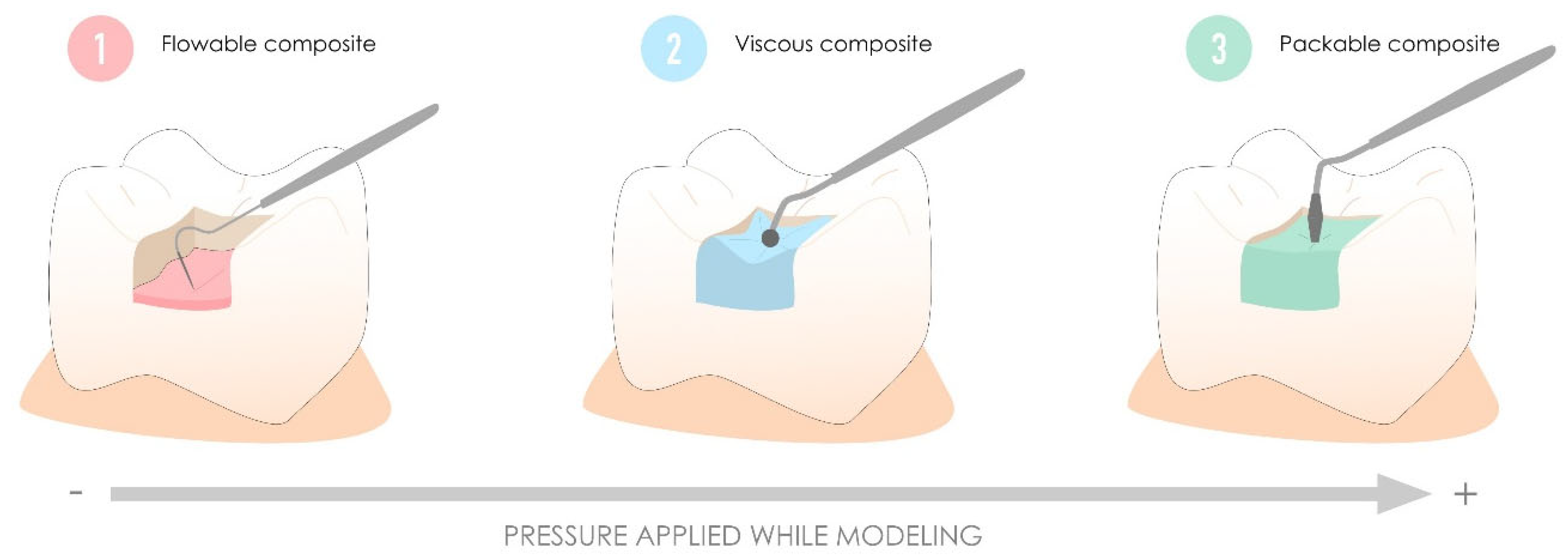


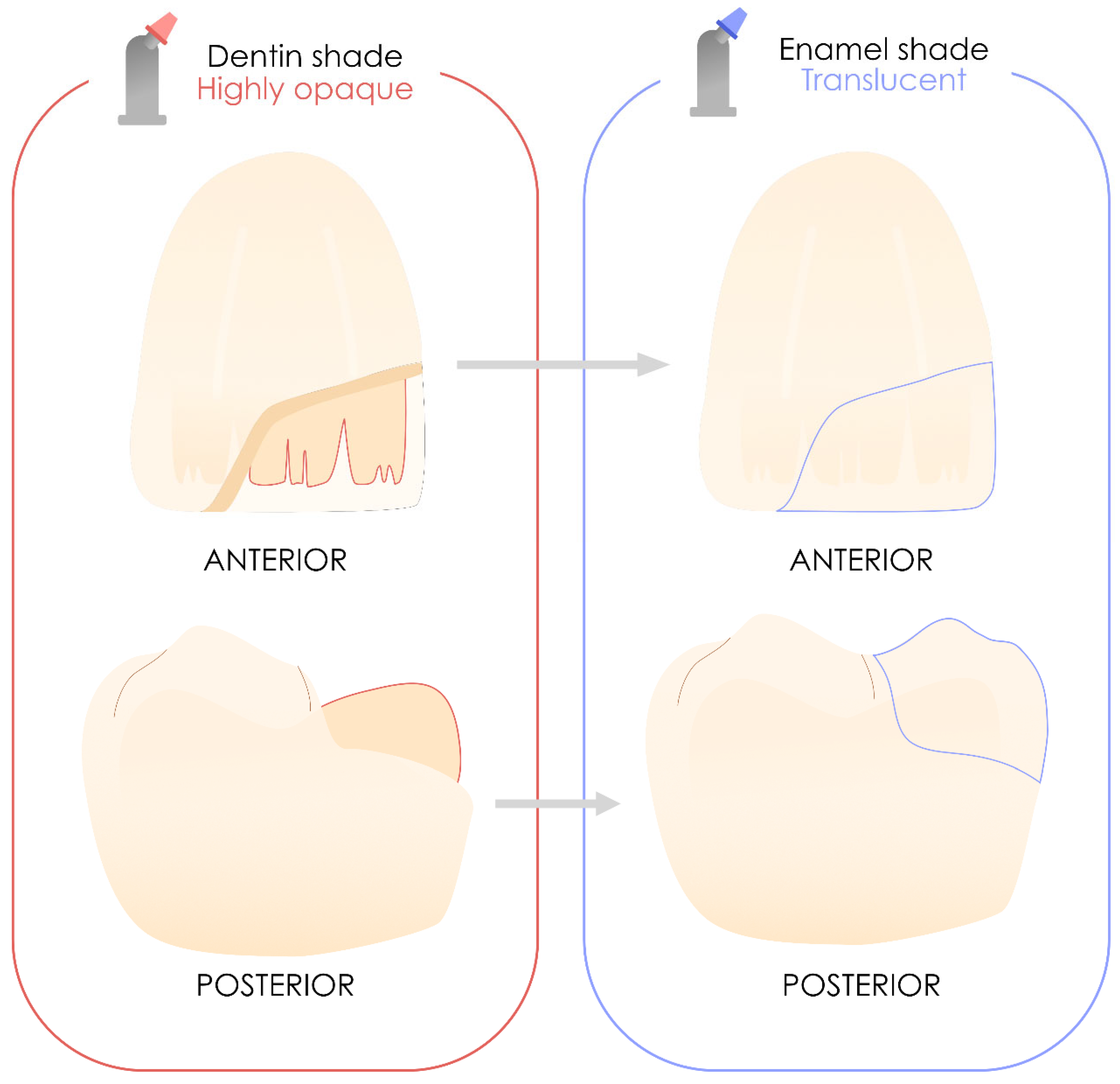

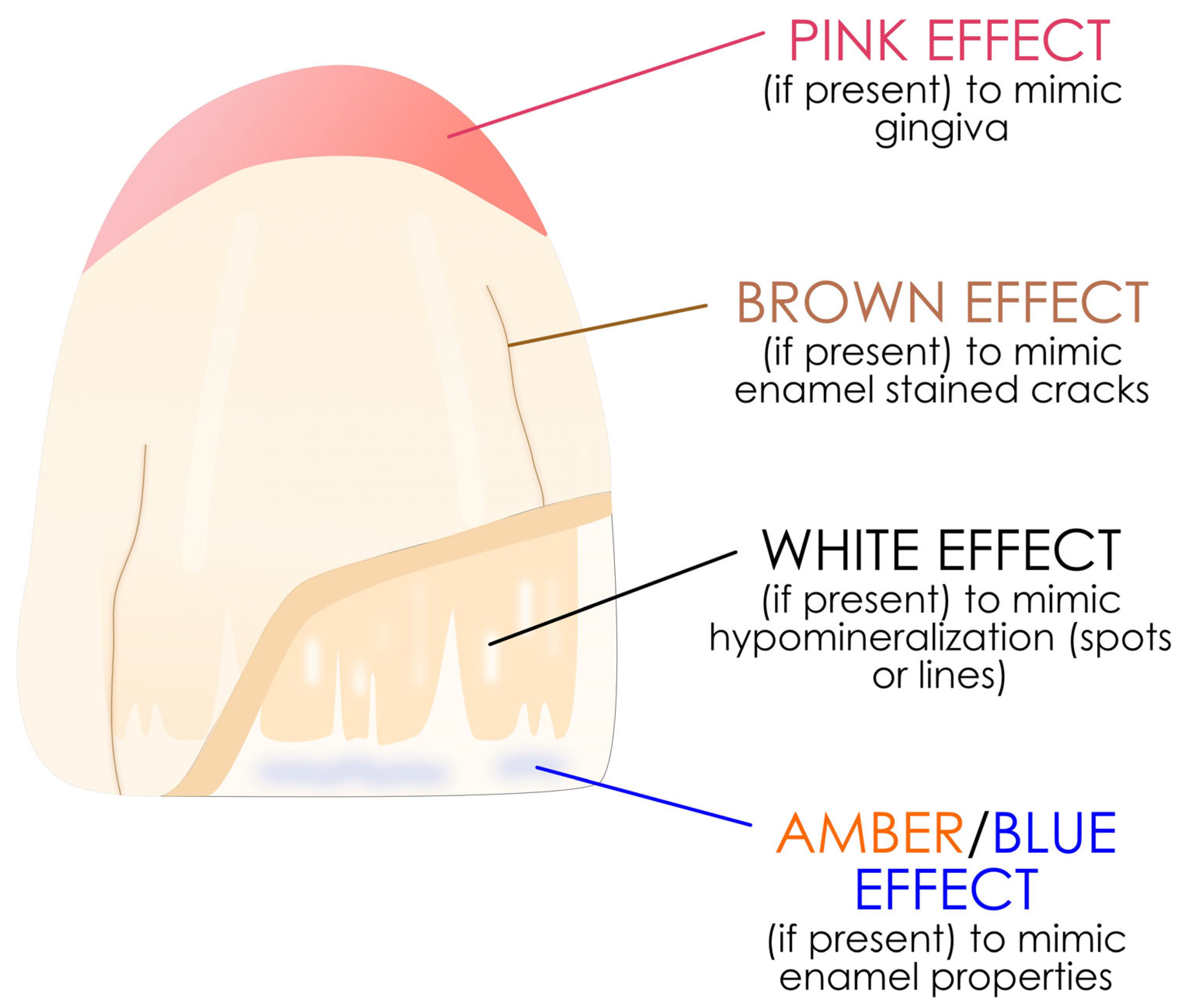
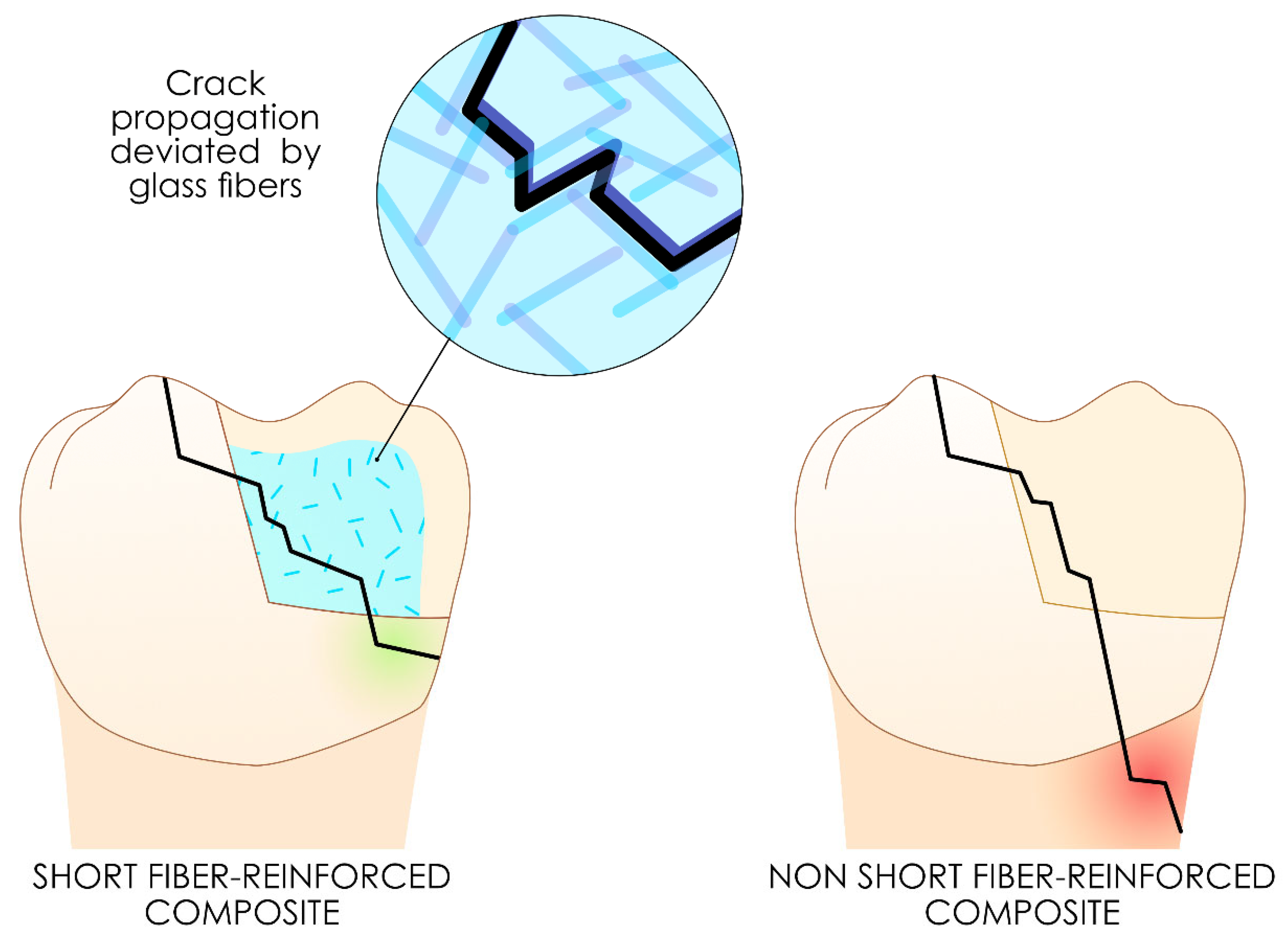

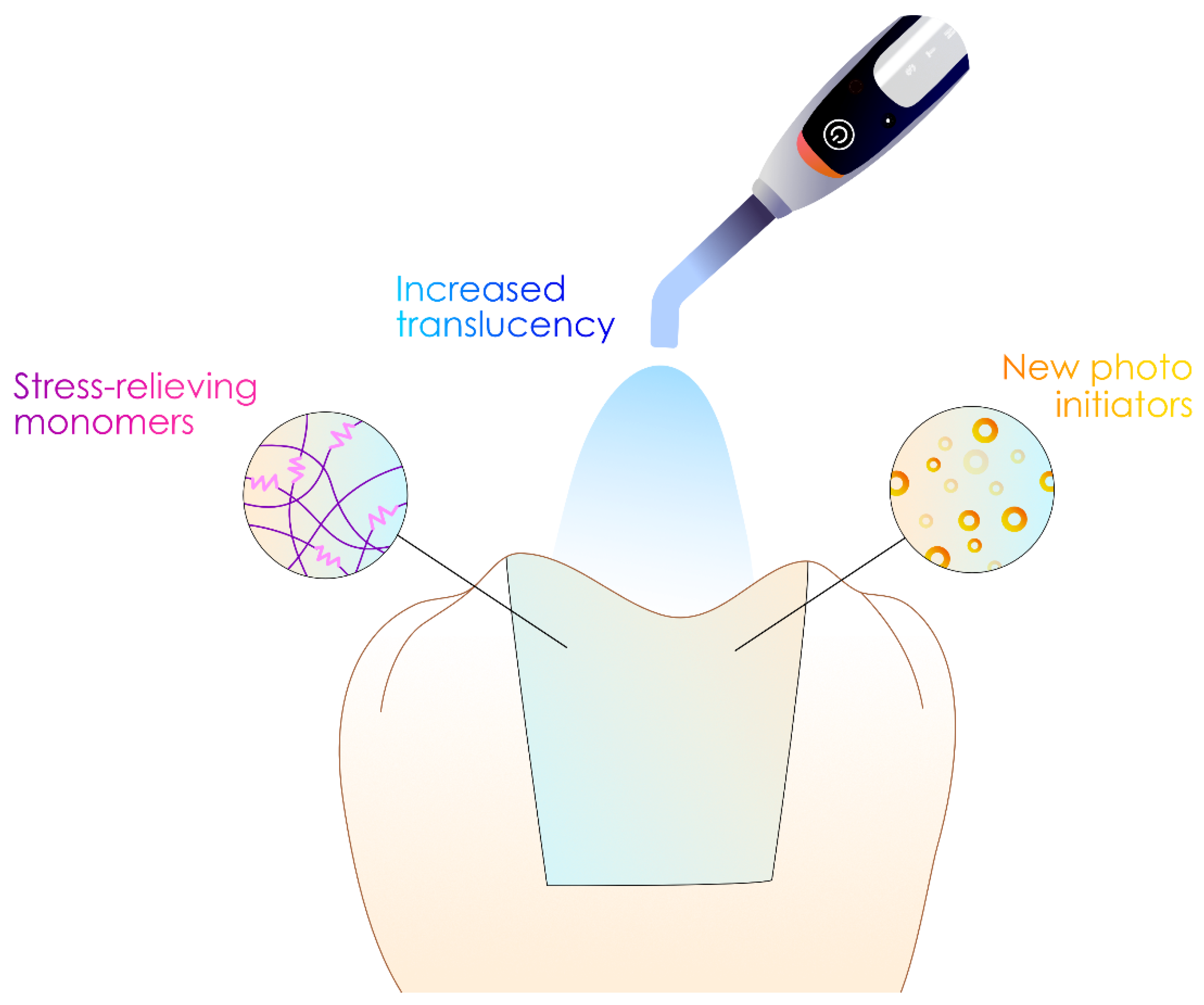
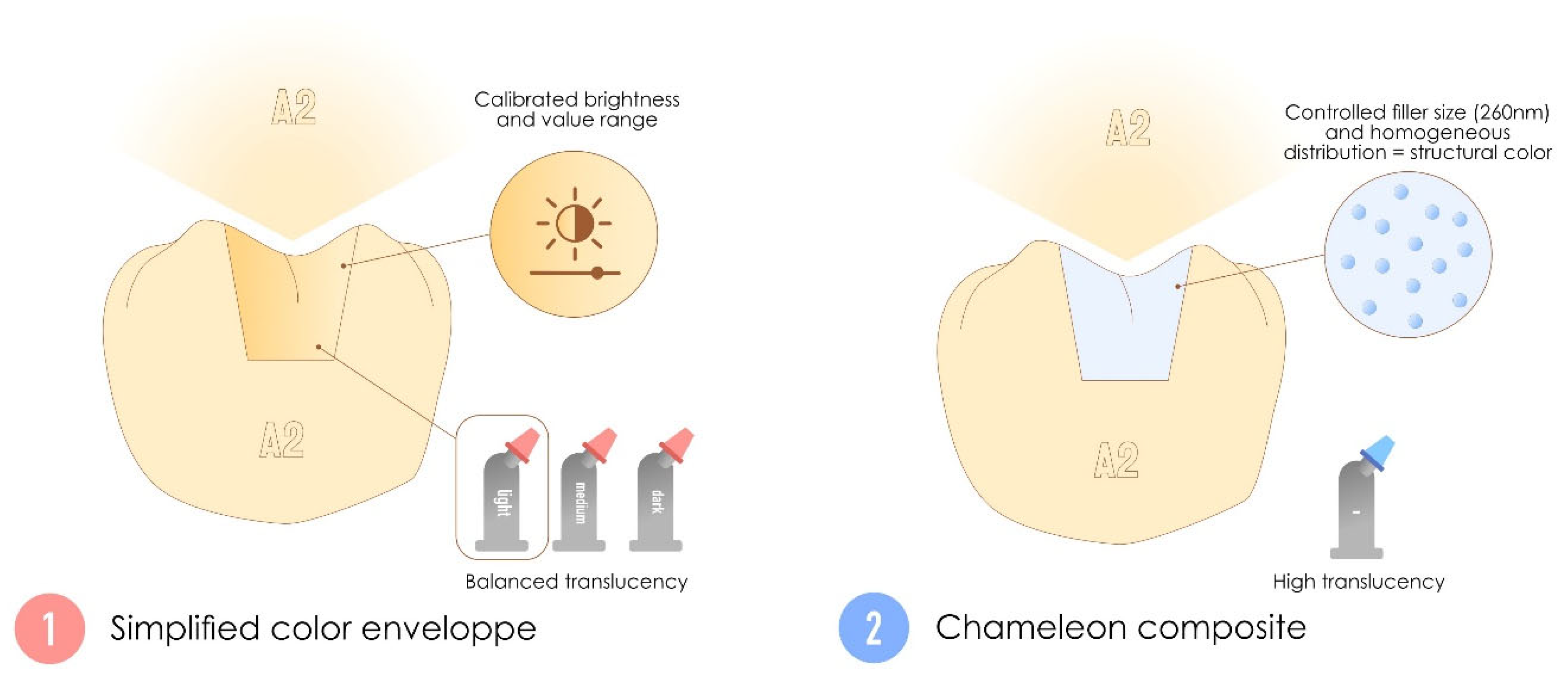

Disclaimer/Publisher’s Note: The statements, opinions and data contained in all publications are solely those of the individual author(s) and contributor(s) and not of MDPI and/or the editor(s). MDPI and/or the editor(s) disclaim responsibility for any injury to people or property resulting from any ideas, methods, instructions or products referred to in the content. |
© 2025 by the authors. Licensee MDPI, Basel, Switzerland. This article is an open access article distributed under the terms and conditions of the Creative Commons Attribution (CC BY) license (https://creativecommons.org/licenses/by/4.0/).
Share and Cite
Francois, P.; Izart, M.; Fasham, T.; Smail, Y.; Jannot, M.; Le Goff, S.; Beres, F.; Troizier-Cheyne, M.; Bergman, S.; Moussally, C.; et al. Proposal of a Modular Classification System for Direct Dental Resin Composites Based on Clinical Applications. Polymers 2025, 17, 564. https://doi.org/10.3390/polym17050564
Francois P, Izart M, Fasham T, Smail Y, Jannot M, Le Goff S, Beres F, Troizier-Cheyne M, Bergman S, Moussally C, et al. Proposal of a Modular Classification System for Direct Dental Resin Composites Based on Clinical Applications. Polymers. 2025; 17(5):564. https://doi.org/10.3390/polym17050564
Chicago/Turabian StyleFrancois, Philippe, Mathieu Izart, Timothy Fasham, Yasmine Smail, Marie Jannot, Stéphane Le Goff, Fleur Beres, Max Troizier-Cheyne, Sara Bergman, Christian Moussally, and et al. 2025. "Proposal of a Modular Classification System for Direct Dental Resin Composites Based on Clinical Applications" Polymers 17, no. 5: 564. https://doi.org/10.3390/polym17050564
APA StyleFrancois, P., Izart, M., Fasham, T., Smail, Y., Jannot, M., Le Goff, S., Beres, F., Troizier-Cheyne, M., Bergman, S., Moussally, C., Abdel-Gawad, S., Dursun, E., Ceinos, R., Caussin, E., & Attal, J.-P. (2025). Proposal of a Modular Classification System for Direct Dental Resin Composites Based on Clinical Applications. Polymers, 17(5), 564. https://doi.org/10.3390/polym17050564








